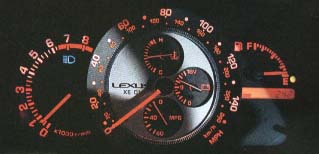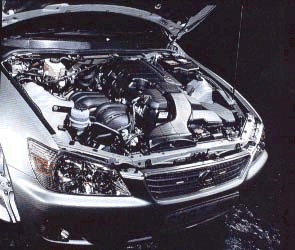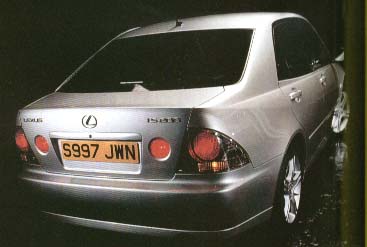



SUITED UP, HAIR SHINY-NEAT, THE VERY model of the sober company man, Nobuaki Katayama, chief engineer on the Lexus IS200, is standing beside a flat-screen display. On the screen is Katayama 15 years ago, unruly hair, toothy grin, in a shiny, polysomething rally jacket and looking out of the driver's window of a rear-drive Toyota Corolla coupe. The shot dissolves into a black-and-white photo of the same Corolla, massively sideways and kicking dust up a mountain dirt road. 'In my early career at Toyota,' he solemnly intones, 'I used to love throwing cars into corners and drifting them around bends with the tail hanging out, and always with me, the driver, in perfect control.'
As a way of setting out your stall to the press, this touches powerful subliminal buttons. So the 3-series has gone soft, he's saying to your subconsicous, and Alfas are front-drive now. If you want a more sporting small saloon, is Katayama's message, you'd better come to me.
He is unveiling a car whose specification,at least, matches the message nicely. The straight-six 2.0-litre engine drives the rear through a siz-speed manual transmission, all four corners using double-wishbone suspension and 17-inch rims.
But the Lexus IS200 has a bigger role than merely creaming off a few drivers from the sporting small saloons of BMW, Audi, Mercedesm Alfra and Saab. It has to provide enough sales to effectively re-launch the Lexus name in Singapore. Compact saloons are by far the biggest market segment for the 'premium brands' and Lexus needs a foot in the door, because it will be charging into other sectors (the RX300 M-class rival, and even a roadster isn't ruled out within five years. The IS200 sells as a Toyota in Japan, where there's no Lexus nameplate - but isn't scheduled for America yet. You get the strong impression that Europe was high in the minds of the people behind this smallest Lexus, and all the key rivals are European.

Nonetheless, it looks Japanese, albeit technoedge Japanese rather than mainstream vanilla Japanese. Its crisp, dart-like profile, big-eyed aggressive face and a strong stance - flared wings stretched over a broad track - could have bathed in the gene pool of Honda S2000 roadster. Its lines don't really say Lexus, but they are rather attractive and sporty. Maybe that's why they don't say Lexus.
Nobody from the Lexus team gathered to unveil it denies that there's more power coming later, but 2.0 litres is clearly a good place to start if you want the best slice of that 'compact-premium' market. Nor is six cylinders too shabby an idea. This engine gives 155bhp, enough for a claimed 215kph and a 9.6sec 0-100kph time, which is just about acceptable for a 2.0, although Alfa's four-pot is notably quicker on the standing-start uptake. A variable inlet cam drive helps clean the exhaust and boost torque, but the best torque peak is nevertheless at 4400 rpm and the power peak at 6200: you get the impression this engine is meant to be revved, taking full advantage of those six close-stacked gear ratios. There's an optional automatic transmission, but it does with just the four ratios.
The engine's mass is centred behind the front axle-line, and overall weight distribution is an even 52:48 front:rear. The all-wishbone suspension system certainly sounds like a good basis for predictable handling, and it's mounted on subframes for a quiet ride.
Katayama's team has completely re-tuned the suspension for Europe, Singapore drivers will get the same set-up as Japan. There's traction control (switchable so as not to rule out Katayama style tail-out entertainment) but none of the ESP-type stability control that's fitted to bigger Lexus cars. Big brakes are made possible by the fitment of 16-inch wheels as the smallest size; 17-inch will be an option though. If the car was tuned for those rims, it should serve up heaps of grip without the harshness and tramlining you'd get if you added them as accessories. Besides, they look business, giving the IS200 a massive dose of chin-out confidence.
Ryouji Okazaki, chief designer, claims that the IS200 didn't originate from a product-planning department brief, but from a group of designers and engineers back-of-an-enveloping the sort of car that would fit their sporting wants with their four-door needs, which explains the short overhangs but accomodating wheelbase.
Jewellery figures large: the front double-lights have visual depth, the grille is a tight mesh, and at the rear, the round lights sit in a chromed plinth behind clear covers.
But it's the cabin where the IS200 really strikes the individual note its designers claim for it. The dial stack purloins an idea - a highly fashionable one - from the watch world. Three subsidary round dials, for volts, temperature, and fuel economy, sit within the speedo's face. To the left of it and slightly siamesed is the rev-counter, and to the right a fuel guage. It's a compact layout, well up in your field of view and easily visible behind the hand-friendly contoured steering wheel.
Okazaki says they did consider compacting the layout even more by making the speedo and rev-counter concentric, but, 'we moved to the present appearance to enhance visibility'. Classic understatement: if they'd stuck to the earlier sketch it would have been completely bewildering.
 Elsewhere,
the cabin is jazzed up by the use of metal, which is effective, and metal-look
plastics, and tacky to touch. The gearknob is immensely businesslike cold metal,
and operates a deliciously precise, short-throw shift. The climate control and
bespoke stereo that occupy the centre console have an upfront design and couldn't
be nore intuitive to use. Front and rear room is impressive for the class, and
the seat cosset and grip you, with a good Recaro-like sporting contour. They're
available in 'sports' fabric (hmmm.... harsh and synthetic) or leather with
Alcantara. The pedals, and a left-foot brace, are drilled aluminium in an optional
sports package. which also provides a Torsen limited-slip differential on the
manual version, twin-tube dampers and stiffer anti-roll bars.
Elsewhere,
the cabin is jazzed up by the use of metal, which is effective, and metal-look
plastics, and tacky to touch. The gearknob is immensely businesslike cold metal,
and operates a deliciously precise, short-throw shift. The climate control and
bespoke stereo that occupy the centre console have an upfront design and couldn't
be nore intuitive to use. Front and rear room is impressive for the class, and
the seat cosset and grip you, with a good Recaro-like sporting contour. They're
available in 'sports' fabric (hmmm.... harsh and synthetic) or leather with
Alcantara. The pedals, and a left-foot brace, are drilled aluminium in an optional
sports package. which also provides a Torsen limited-slip differential on the
manual version, twin-tube dampers and stiffer anti-roll bars.
But elements of the cabin design try too hard: there's a cog-like bezel inside the speedo numbers which look fussy and cheap; the speaker grilles are like something out of a decade - old cheap Hi-Fi system.
We waited anxiously to see if it will cost about as much as obvious rivals, if so it should because of the full spec: the hugh wheels and climate control are standard, and so is a CD changer which swallows six discs one-by-one into the dash slot. It saves you furtling in the boot, but only with the Japanese would you trust your precious music to reappear after use from the bowels of the console. Even the navigation system - easier to use than most and including a nifty colour screen that pops up from the dashtop - could well be thron in.
Given that Singapore both the best market for Lexus in Europe, and a place where the 'prestige' saloon market is most clearly demarcated from the unfortunate mass-market horde, we're likely to see a lot of IS200s on our streets. If it lives up to its on-paper promise, it should shake the class up very nicely indeed.
